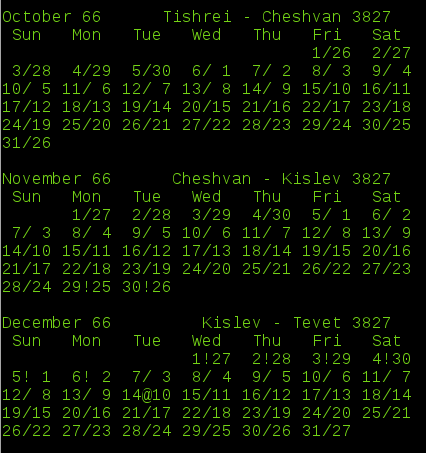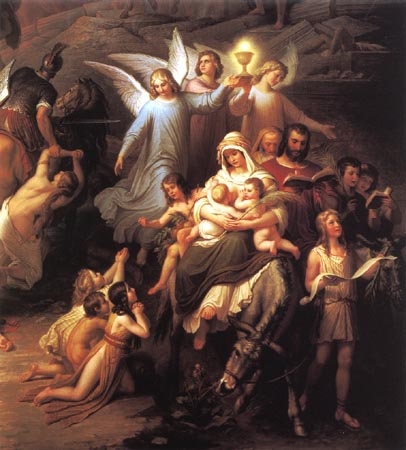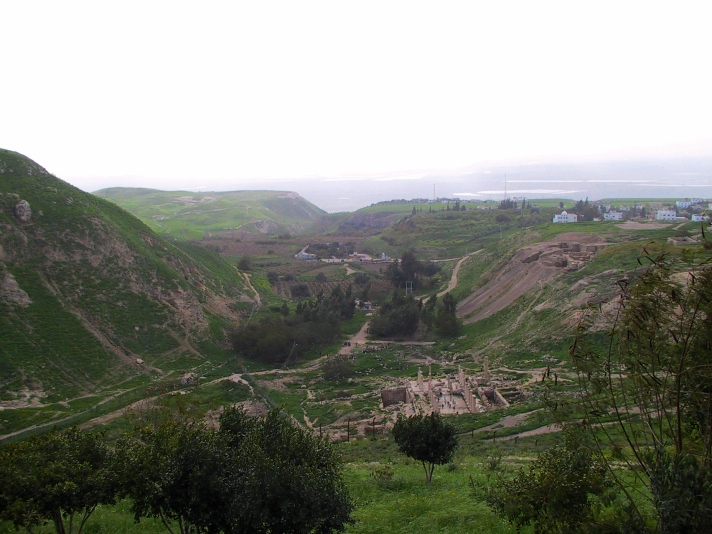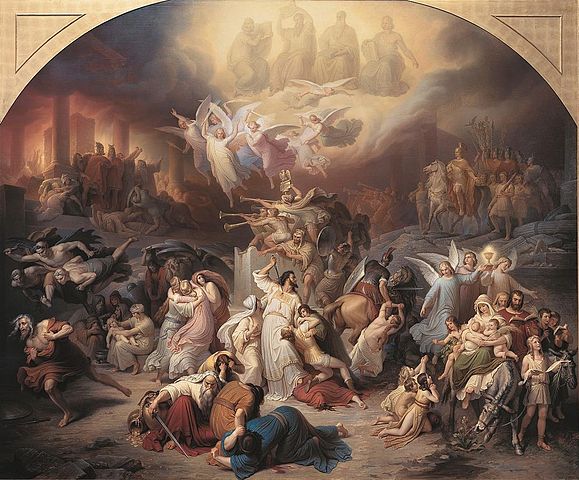And what year were the 42 months fulfilled?
"And I saw one of his heads as it were wounded to death; and his deadly wound was healed." Revelation 13:3. Remember, one of the heads has the little horn. "...The beast... had the wound by a sword, and did live." Revelation 13:14. The Roman pontiff was captured by Napoleon's general, Berthier, on February 15, 1798 A.D., after arriving at Rome on February 9, 1798.[31] This was
exactly 1260 years after 538 A.D., when the eastern emperor made the Roman bishop the head of all Christendom, during which time, the woman with a crown of 12 stars which had given birth to the man-child (the Church and Jesus) fled into the wilderness 1200 and three score (3 X 20) "days." Revelation 12:1-6. Prophetically, each day stands for a year. Nos. 14:34. Ezekiel 4:6. The deadly wound was healed when the church again gained autonomy in 1929 by the Vatican City becoming an independent state.
Here's how the stage was set for the deadly wound. Martin Luther, a German parish priest, sought to reform the church when he found his parishioners crossing the river to buy letters of indulgence bearing the name of the pope. Purchasers were told that not only were they relieved of the temporal consequences of their sins, but the souls of their grandparents were released from purgatory. It was later learned "that some of these funds were designed to service the debt of the large fee imposed by the pope on Margrave Albrecht of Brandenburg as the price of allowing him to combine the archbishopric of Mainz with the archbishopric of Magdeburg." In response Luther authored 95 theses in October 1517.[32] Apparently, however, the majority of the funds went towards the building of the Vatican and the new St. Peter's Basilica. Martin Luther declared "I have sought nothing beyond reforming the church in conformity with the Holy Scriptures. The spiritual powers have been not only corrupted by sin, but absolutely destroyed; so that there is now nothing in them but a depraved reason and a will that is the enemy and opponent of God. I simply say that Christianity has ceased to exist among those who should have preserved it." However, the church would not be reformed. In 1521 Luther was summoned before the Council of Worms where he declared: "Unless I am convicted by scripture and plain reason - I do not accept the authority of popes and councils, for they have contradicted each other - my conscience is captive to the word of God. I cannot and I will not recant anything, for to go against conscience is neither right nor safe.... Here I stand, I cannot do otherwise."[33] Knowing that the church wasn't true, people began to leave in droves to form new churches. "In France, England, and the Netherlands, hundreds of common people, women as well as men, were content to be burnt alive for their newly acquired Protestant beliefs."[34]
At the time of the Roman bishop's capture in 1798, he was declared deposed. He was taken to France where he died at Valence on August 29, 1799. The pope's 1260 years of political power had come to an end. Although a new bishop was elected by 1800, the church had lost its papal state to Napolean.
As for the 1290 days/years in Daniel 12
Many scholars have interpreted verse 31 as occurring during the reign of Antiochus Epiphanes, but this cannot be because 200 years after Antiochus, Jesus said: "When ye therefore shall see the abomination of desolation, spoken of by Daniel the prophet, stand in the holy place (whoso readeth, let him understand

Then let them which be in Judaea flee into the mountains...." Matthew 24:15-16. The Roman Church is the MOTHER OF ABOMINATIONS OF THE EARTH; Rome starts the inquisition; "from the time that the daily sacrifice shall be taken away, and the abomination that maketh desolate set up" is 1290 days [years], Daniel 12:11. 1290 years from 168 BC, when Antiochus Epiphanes desecrated the Temple and took away the daily sacrifice, to 1122 AD brings us to the Concordat of Worms (Pactum Calixtinum) signed on September 23, 1122, which brought the investiture contest to a close. This is often called a peace treaty between the papacy and the empire. A similar agreement had already been reached with the English king in 1107. At Worms the German emperor of the Holy Roman Empire agreed that the bishop of Rome should elect bishops and abbots and invest them with the ring and staff, symbols of their spiritual authority. The emperor gave up his prior right to elect bishops and invest them, although he did keep the right to invest them with the scepter, the symbol of secular authority. However, now the bishops answered to the bishop of Rome, rather than the emperor, which was in reality a huge jump in power. The following is King Henry's part of the agreement:
In the name of the holy and indivisible Trinity, I, Henry by the grace of God Emperor Augustus of the Romans, for the love of God and of the holy Roman church and of the Lord Pope Calixtus, and for the cure of my soul, give up to God, and to the holy Apostles of God, Peter and Paul, and to the holy catholic Church all investiture by ring and crozier, and I grant that, in all churches which are in my kingdom or empire, there may be canonical election and free consecration. I restore to the same Roman church such possessions and regalia of St. Peter as I have which were taken away between the beginning of this conflict and the present day, whether in the time of my father or in my own; and I shall faithfully assist to the end that those which I do not have may be restored. With the counsel of princes, and by justice, I shall also give back such possessions as I have of all other churches and princes and others, both clergy and laymen, which were lost in this war, and I shall faithfully assist to the end that those which I do not have be given back. And I give true peace to the Lord Pope Calixtus and to the Roman church and to all who are, or have been, on its side. And I shall faithfully assist in such matters as the holy Roman church asks aid, and I shall do the justice due it in such things as it complains about....
The first immediate result of the agreement was that half of the land and wealth of Germany passed from the control of the emperor to the Roman pontiff since these were in the hands of bishops and abbots.[97]
Many historians seem to overlook the importance of the Concordat, but the Roman Church did not. It knew it had won a great victory in temporal power for which it had sought for hundreds of years although the lay investiture controversy was the last aspect of the battle lasting approximately 75 years. "That he was the spiritual head of the [Roman] Church would hardly have been questioned before, but his authority had been rather that of a suzerain, who was expected to leave the local archbishops and bishops in independent control of their own districts. In imitation of the policy of the temporal rulers, the Popes had striven, with a large measure of success, to convert this suzerainty into a true sovereignty."[98] The papacy now viewed itself as supreme - as the head of the kingdom which would never be destroyed. Calixtus summoned the First Lateran Council, a huge gathering in 1123, which became largely a celebration for the signing of the Concordat and approval of it. The Council's canons of 3,4,8 and 12 address the investiture subject.[99]
Calixtus also had plans for St. Peter's where pilgrims who traveled to its altar every three years received a remission of sins.
Calixtus could have rebuilt the altar and left its identification with Sylvester intact, as Gregory I had done, but by totally concealing the older altar [by building a new one over it], and engraving his own name upon the new one, he superceded Sylvester as the most visible heir of St. Peter. When pilgrims came to the most holy spot in St. Peter's, they would see his name.... Calixtus encouraged this association by bringing the whole First Lateran Council to St. Peter's to participate in the consecration of the altar. The pope and what is estimated to have been between three hundred and one thousand bishops, abbots and cardinals celebrated the consecration on March 25, 1123, as the culmination of the council summoned in large part to approve the Concordat of Worms. The scene was reminiscent of the consecration of the first altar by Sylvester. The date - the anniversary of the feast of the Annunciation of the Blessed Mary - was also carefully chosen. The feast off the annunciation was one of the principal festivals of the year, but the festival of the dedication of the altar would take precedence over it. Every year Christians would be reminded of Calixtus when the confessio was decorated with a mappula and torches in commemoration of the dedication of the altar 'facta a papa Calixto.'[100]
Prior to the Concordat of Worms the bishop of Rome claimed to wield one of the two swords of God created to rule mankind - His spiritual sword. The temporal sword was wielded by the emperor (remember how church historians conceived Constantine as welding the two world's together). After the Concordat of Worms, the canon lawyers began asserting that both swords belonged to the bishop of Rome, who delegated the temporal sword to the emperor. Thus, the bishop of Rome crowned himself with the third crown of his papal tiara. The third crown represented the pontiff's authority over the kings of the world. The second crown represented his spiritual power over mankind, and the first crown symbolized his temporal sovereignty over the papal states.[101] "After Worms... the papacy's star was in the ascendant for the rest of the century, rising to its highest point with the accession of Innocent III in 1198." "The medieval papacy had now reached the zenith of its spiritual and temporal power."[102]





